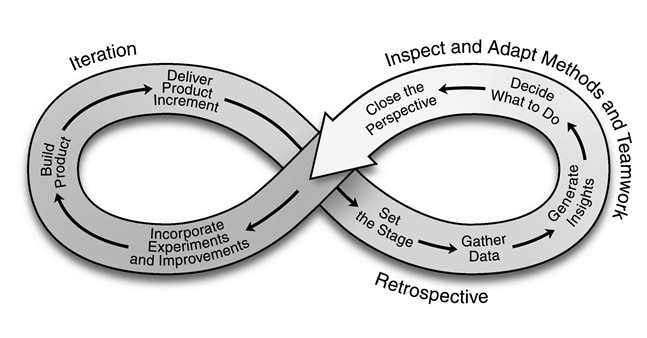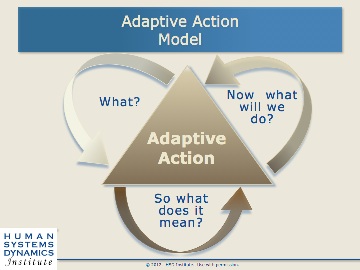Diana has written previously about the Human Systems Dynamics Institute and their excellent program that provides models and methods for dealing with our VUCA (volatile, uncertain, complex, ambiguous) world of complex adaptive human systems. In this post she focuses on the HSD Adaptive Action model and its unexpected connection to retrospectives:
In 2006 Esther and I introduced a Flexible Framework for Agile Retrospectives, a series of stages for designing effective retrospectives: Set the Stage; Gather Data; Generate Insights; Decide What to Do; and Close the Retrospective. We recommended a recurring cycle of retrospectives after each iteration as a process for the team to "reflect, tune and adjust", as the Agile Manifesto principle decrees.

While a defined opening and closing belong in any effectively facilitated meeting, what happens in between looks very much like HSD's Adaptive Action cycle. Put simply, it goes like this: What? So What? Now What?
“Adaptive Action provides an iterative process of seeing the patterns in the environment, planning for change, and the re-scanning the environment to see what is needed next. Adaptive Action can be used to bring about both short-term, operational, day-to-day change and longer term improvements. It is a process that can be used at any level of the organization at any time...All it requires is a commitment to improvement based on data from the environment and the willingness to review progress continuously.” - Royce Holladay and Kristine Quade, Influencing Patterns for Change: A Human Systems Dynamics Primer for Leaders.

HSD provides group activities for understanding complex adaptive human systems that fit the purpose of each part of the model.
An example:
In "What?" a retrospective facilitator shows the team how to describe its environment in terms of Containers, Differences, and Exchanges (CDE conditions for self-organizing) or guides team members to brainstorm the ways this iteration was the Same and Different from previous ones. The team asks questions, collects data, and observes patterns. They ask “What just happened or is happening now with regard to the focus of this retrospective?”
In "So What?", the team looks for patterns and analyzes how those patterns influence their work or examines the Generative STAR model to identify areas of strengths and challenges or reflect on the implications of differences in Decision Map models between the team and its customers. They seek to understand what is important about the “what,” they analyze the data, and make meaning of it. They ask, “What patterns help us? How could we shift patterns that don’t help us? What CDEs exist, and how can we move them to create different patterns?”
In "Now What?", the team chooses one adaptive action to implement in the next iteration. While implementing it, team members observe the new patterns that emerge, and collect new data to bring to the next retrospective.
Adaptive Action iterates, pays attention to patterns, flexes to accommodate new data, sees many dimensions, and relies on fast cycles.
“Using an iterative cycle of 'What?' 'So What?' 'Now What?' helps planning (for continuous improvement) move progressively forward.” - Holladay and Quade
And Now What?
If you're interested in learning more about the HSD program and/or the models and methods for working in complex adaptive human systems during complex times, check out the website for resources, upcoming events, and links to webinars.